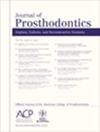Effects of post‐curing light intensity on the trueness, compressive strength, and resin polymerization characteristics of 3D‐printed 3‐unit fixed dental prostheses
IF 3.4
2区 医学
Q1 DENTISTRY, ORAL SURGERY & MEDICINE
Journal of Prosthodontics-Implant Esthetic and Reconstructive Dentistry
Pub Date : 2024-09-13
DOI:10.1111/jopr.13951
引用次数: 0
Abstract
PurposeTo investigate the effect of different post‐curing light intensities on the trueness, compressive strength, and resin polymerization of 3D‐printed 3‐unit fixed dental prostheses (FPD).Materials and MethodsA total of 60 specimens were prepared to support a 3‐unit FDP with a deep chamfer marginal design, utilizing computer‐aided design and computer‐aided manufacturing (CAD‐CAM) technology. Light‐polymerizing FDP resin with varying light intensities (105, 210, 420, and 840 mW/cm后固化光强度对 3D 打印三单元固定义齿的真实性、抗压强度和树脂聚合特性的影响
材料与方法利用计算机辅助设计和计算机辅助制造(CAD-CAM)技术,制备了 60 个试样,以支持具有深倒角边缘设计的 3 单元 FDP。使用不同光强度(105、210、420 和 840 mW/cm2)的光聚合 FDP 树脂 10 分钟。随后,进行了真实性评估、断裂负荷测试、扫描电子显微镜(SEM)表面检查和傅立叶变换红外(FTIR)分析。结果210 mW/cm2 组的真实度最高(57.6 ± 2.1 µm),而 840 mW/cm2 组的偏差最大(79.3 ± 2.7 µm)(p <0.001)。光照强度为 105、210、420 和 840 mW/cm2 组的平均断裂强度分别为 1149.77 ± 67.81 N、1264.92 ± 39.06 N、1331.34 ± 53.62 N 和 1439.93 ± 34.58 N(p <0.001)。树脂聚合分析表明,O-H 和 C-H 拉伸振动的峰值强度在 3579 cm-1 处激增,但暴露于 105 mw/cm2 光的样品除外,其最低峰值在 2890 cm-1 处。在 840 mW/cm2 的条件下,树脂聚合的性能最为显著。然而,光照强度为 840 mW/cm2 的抗压强度最高。此外,除 105 mW/cm2 外,所有后处理光强度下都出现了聚合现象。这些研究结果表明,虽然低强度使用能提供更高的真实度,但高强度使用能提供更好的抗压强度和聚合度。因此,210 mW/cm2 可以作为后固化的推荐方案。
本文章由计算机程序翻译,如有差异,请以英文原文为准。
求助全文
约1分钟内获得全文
求助全文
来源期刊

Journal of Prosthodontics-Implant Esthetic and Reconstructive Dentistry
DENTISTRY, ORAL SURGERY & MEDICINE-
CiteScore
7.90
自引率
15.00%
发文量
171
审稿时长
6-12 weeks
期刊介绍:
The Journal of Prosthodontics promotes the advanced study and practice of prosthodontics, implant, esthetic, and reconstructive dentistry. It is the official journal of the American College of Prosthodontists, the American Dental Association-recognized voice of the Specialty of Prosthodontics. The journal publishes evidence-based original scientific articles presenting information that is relevant and useful to prosthodontists. Additionally, it publishes reports of innovative techniques, new instructional methodologies, and instructive clinical reports with an interdisciplinary flair. The journal is particularly focused on promoting the study and use of cutting-edge technology and positioning prosthodontists as the early-adopters of new technology in the dental community.
 求助内容:
求助内容: 应助结果提醒方式:
应助结果提醒方式:


